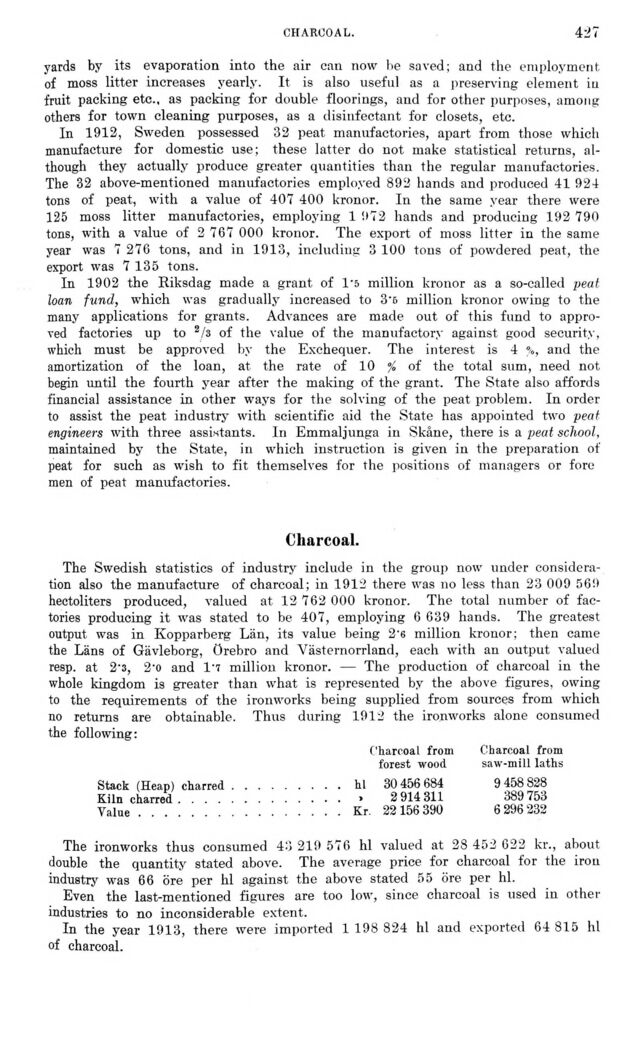
Full resolution (JPEG) - On this page / på denna sida - VII. Manufacturing Industries. Introd. by [G. Sundbärg] K. Åmark - 8. Manufactures of Stone, Clay, Coal, Charcoal, and Peat - Peat Manufacture. By Alf. Larson - Charcoal. By Alf. Larson

<< prev. page << föreg. sida << >> nästa sida >> next page >>
Below is the raw OCR text
from the above scanned image.
Do you see an error? Proofread the page now!
Här nedan syns maskintolkade texten från faksimilbilden ovan.
Ser du något fel? Korrekturläs sidan nu!
This page has never been proofread. / Denna sida har aldrig korrekturlästs.
charcoal.
427
yards by its evaporation into the air can now be saved; and the employment
of moss litter increases yearly. It is also useful as a preserving element iu
fruit packing etc., as packing for double floorings, and for other purposes, among
others for town cleaning purposes, as a disinfectant for closets, etc.
In 1912, Sweden possessed 32 peat manufactories, apart from those which
manufacture for domestic use; these latter do not make statistical returns,
although they actually produce greater quantities than the regular manufactories.
The 32 above-mentioned manufactories employed 892 hands and produced 41 924
tons of peat, with a value of 407 400 kronor. In the same year there were
125 moss litter manufactories, employing 1 972 hands and producing 192 790
tons, with a value of 2 767 000 kronor. The export of moss litter in the same
year was 7 276 tons, and in 1913, including 3 100 tons of powdered peat, the
export was 7 135 tons.
In 1902 the Riksdag made a grant of l’S million kronor as a so-called peat
loan fund, which was gradually increased to 3’b million kronor owing to the
many applications for grants. Advances are made out of this fund to
approved factories up to 2/3 of the value of the manufactory against good security,
which must be approved by the Exchequer. The interest is 4 %, and the
amortization of the loan, at the rate of 10 % of the total sum, need not
begin until the fourth year after the making of the grant. The State also affords
financial assistance in other ways for the solving of the peat problem. In order
to assist the peat industry with scientific aid the State has appointed two peat
engineers with three assistants. In Emmaljunga in Skåne, there is a peat school,
maintained by the State, in which instruction is given in the preparation of
peat for such as wish to fit themselves for the positions of managers or fore
men of peat manufactories.
Charcoal.
The Swedish statistics of industry include in the group now under
consideration also the manufacture of charcoal; in 1912 there was no less than 23 009 569
hectoliters produced, valued at 12 762 000 kronor. The total number of
factories producing it was stated to be 407, employing 6 639 hands. The greatest
output was in Kopparberg Län, its value being 2’6 million kronor; then came
the Läns of Gävleborg, Örebro and Västernorrland, each with an output valued
resp. at 2’3, 2’0 and 1*7 million kronor. — The production of charcoal in the
whole kingdom is greater than what is represented by the above figures, owing
to the requirements of the ironworks being supplied from sources from which
no returns are obtainable. Thus during 1912 the ironworks alone consumed
the following:
Charcoal from Charcoal from
forest wood saw-mill laths
Stack (Heap) charred.........hi 30 456 684 9 458 828
Kiln charred............. > 2 914 311 389 753
Value................Kr. 22156 390 6 296 232
The ironworks thus consumed 43 219 576 hi valued at 28 452 622 kr., about
double the quantity stated above. The average price for charcoal for the iron
industry was 66 ore per hi against the above stated 55 ore per hi.
Even the last-mentioned figures are too low, since charcoal is used in other
industries to no inconsiderable extent.
In the year 1913, there were imported 1 198 824 hi and exported 64 815 hi
of charcoal.
<< prev. page << föreg. sida << >> nästa sida >> next page >>